| Pages:
1
2 |
tacromx
Harmless

Posts: 7
Registered: 25-9-2015
Member Is Offline
Mood: No Mood
|
|
Magnetic Carbon?
So the day before i cooked up some sugar and zinc chloride in a 1:1 ratio in de-ionized water, cooked at 500c for 3 hours and at the end i got a very
light carbon structure which i powdered afterwards. I then blasted it 3 times for 10 seconds in my 800w microwave oven(sparkles and smoked quite a
bit). Purely out of curiosity i wanted to see if it was magnetic,took a magnet to the bottom of the glass container and indeed it was!!. How can this
be?, can anyone explain this to me?.
Thanks in advance.
|
|
|
elementcollector1
International Hazard
    
Posts: 2684
Registered: 28-12-2011
Location: The Known Universe
Member Is Offline
Mood: Molten
|
|
Pyrolytic graphite responds to magnets, but I'm unsure if you managed to make that with such an unusual procedure. Did you really just throw all this
together, or were you after some other end product?
Elements Collected:52/87
Latest Acquired: Cl
Next in Line: Nd
|
|
|
Texium
|
Thread Moved
21-2-2018 at 15:15 |
aga
Forum Drunkard
    
Posts: 7030
Registered: 25-3-2014
Member Is Offline
|
|
Likelihood % = 0. Damn.
Shame really.
Anyone with a furnace capable of maintaining 500 C for 3 hours could do a very wide range of interesting things.
|
|
|
Morgan
International Hazard
    
Posts: 1660
Registered: 28-12-2010
Member Is Offline
Mood: No Mood
|
|
Could zinc chloride at 500c have leached iron or nickel from a vessel if a metal container was used? Or could the carbon have an electrostatic charge
that may have responded to the magnet or other materials for no other reason than static attraction?
I was thinking the carbon being so light, that even traces of iron might be plenty to create an attraction.
"This invention relates to the removal of iron which is contained as an impurity in the ferrous state in aqueous solutions of chemicals, as in the
manufacture of zinc sulfate and zinc chloride."
"In the manufacture of zinc salts the crude liquors contain varying amounts of ferrous iron, depending upon the source of the raw materials and the
particular methods of operation."
http://www.freepatentsonline.com/2369270.html
[Edited on 22-2-2018 by Morgan]
|
|
|
tacromx
Harmless

Posts: 7
Registered: 25-9-2015
Member Is Offline
Mood: No Mood
|
|
Since im mainly into battery research i needed a kiln for making activated carbons, so i made one. My procedure was exactly as described in my first
post. I was not happy with the conductivity of my first batch and thought i might try it in the microwave, it has made the conductivity quite a bit
lower(down to 32ohms from 823ohms).
Thanks for replying.
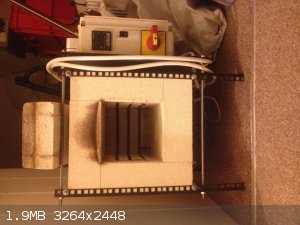 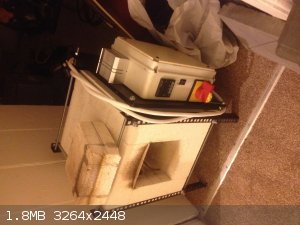
|
|
|
tacromx
Harmless

Posts: 7
Registered: 25-9-2015
Member Is Offline
Mood: No Mood
|
|
Magnetic Carbon?
@Morgan
Yes it was a metal container.
Guess ill have to invest in a graphite crucible to know for certain then.
thanks for the reply.
[Edited on 22-2-2018 by tacromx]
|
|
|
Melgar
Anti-Spam Agent
    
Posts: 2004
Registered: 23-2-2010
Location: Connecticut
Member Is Offline
Mood: Estrified
|
|
Were you moving it through a magnetic field, or moving he magnet past it? Graphite is conductive, and theoretically would respond to a moving
magnetic field in the same way that nonmagnetic metal particles would when moved through a magnetic field. THe effect would be minor, but with small
particles suspended in liquid, you might be able to notice it.
edit: Have you tried making lampblack? That's how they used to make carbon particles back in the day.
[Edited on 2/22/18 by Melgar]
The first step in the process of learning something is admitting that you don't know it already.
I'm givin' the spam shields max power at full warp, but they just dinna have the power! We're gonna have to evacuate to new forum software!
|
|
|
tacromx
Harmless

Posts: 7
Registered: 25-9-2015
Member Is Offline
Mood: No Mood
|
|
@Melgar
I have the carbon in a 500ml borosilicate beaker, when i place a 10x10mm neodymium underneath touching the bottom and move it, the carbon particles
move with the magnet, kind of like the old etchasketch toy, or iron fillings on paper. Must say as an active material on my aluminium/copper battery
it has increased the runtime quite considerably.
Carbon black?, ill have to have a go at that if i can find instructions detailing the procedure.
I have tried a run at graphitic carbon nitride as well at 550c, but had to stop it after an hour because i over filled the container and the ammonium
fumes became ridiculous at which point i started thinking about a change of underpants 
I did however manage to get a yellowish brittle solid, have no idea if this is gcn or something else?
thanks for your reply.
[Edited on 22-2-2018 by tacromx]
|
|
|
BromicAcid
International Hazard
    
Posts: 3227
Registered: 13-7-2003
Location: Wisconsin
Member Is Offline
Mood: Rock n' Roll
|
|
Magnetic biochar for cleaning water
https://pubs.acs.org/doi/suppl/10.1021/acs.jchemed.6b00154
|
|
|
Morgan
International Hazard
    
Posts: 1660
Registered: 28-12-2010
Member Is Offline
Mood: No Mood
|
|
Another biochar tidbit
http://www.biochar-international.org/node/3833
|
|
|
Melgar
Anti-Spam Agent
    
Posts: 2004
Registered: 23-2-2010
Location: Connecticut
Member Is Offline
Mood: Estrified
|
|
Black iron oxide is magnetic, and would be indistinguishable from carbon particles visually. I have a friend with more money than he knows what to do
with, that fancies himself an alchemist. He somehow thought that he could get a form of rhodium by extracting it from grape juice. And that he could
tell he had it when it responded to a magnetic field. (I know, I know. Bear with me.)
I saw the demonstration, and indeed there was a black powder that responded to a magnetic field. So I just immediately said "probably black iron
oxide". He asked if there was some test he could do to confirm whether that's what it was. I had to think about it a little, but then realized
adding hydrochloric acid to iron oxide should make it turn bright yellow, as FeCl3 forms. He did this, and indeed, it slowly turned yellow. He was
disappointed, to say the least, and kind of in denial. So he asks "is there some other test I could do on it?" I'm like "yeah, you can see if it
responds to a FUCKING MAGNET. Rhodium won't!"
To make lampblack, just light a candle or an oil lamp, and put the bottom of a glass beaker directly in the yellow part of the flame. The beaker
should have room temperature water in it so the carbon on the glass doesn't burn. Don't get it so cold that water condenses on it out of the air
though. Carbon builds up kind of slowly, but if you leave it and come back to it in like an hour, there will be a considerable amount. I'm not sure
how much you need, and there are better ways if you need large amounts, but with this method you just need a candle and a lighter.
The first step in the process of learning something is admitting that you don't know it already.
I'm givin' the spam shields max power at full warp, but they just dinna have the power! We're gonna have to evacuate to new forum software!
|
|
|
DrP
National Hazard
   
Posts: 625
Registered: 28-9-2005
Member Is Offline
Mood: exothermic
|
|
Quote: Originally posted by Melgar  |
To make lampblack, just light a candle or an oil lamp, and put the bottom of a glass beaker directly in the yellow part of the flame. The beaker
should have room temperature water in it so the carbon on the glass doesn't burn..... you just need a candle and a lighter. |
Do you know if you can get any bucky balls out of that black? I have no idea how they are currently made, but I think they were discovered as a very,
very small by-product of candle soot originally.
\"It\'s a man\'s obligation to stick his boneration in a women\'s separation; this sort of penetration will increase the population of the younger
generation\" - Eric Cartman
|
|
|
Sulaiman
International Hazard
    
Posts: 3558
Registered: 8-2-2015
Location: 3rd rock from the sun
Member Is Offline
|
|
Graphite is diamagnetic ... repelled from a magnetic field gradient.
I use either pyrolytic graphite (best) or graphite foil(cheap) to 'levitate' above neodymium magnets.
So the effect may look like the attraction of iron filings but is probably a repulsion.
You would have to move a magnet quite quickly to induce significant Lorentz force in graphite.
Even water is observably repelled by a powerful magnetic field gradient.
CAUTION : Hobby Chemist, not Professional or even Amateur
|
|
|
MrHomeScientist
International Hazard
    
Posts: 1806
Registered: 24-10-2010
Location: Flerovium
Member Is Offline
Mood: No Mood
|
|
Try just placing the magnet on the outside of the container, not moving it. If you tilt the container and particles stick to where the magnet is, they
are magnetic to some degree. If they only respond to a moving magnet, it's likely a force generated by Lenz's Law. The former, to me, indicates iron
contamination, and the latter could be from the carbon being conductive. Although I've never heard of carbon behaving this way, it would be
interesting if it did.
What was the goal of your original experiment?
|
|
|
tacromx
Harmless

Posts: 7
Registered: 25-9-2015
Member Is Offline
Mood: No Mood
|
|
It's contamination i suspect, tried a small sample in hydrochloric acid, as you can see from the picture its green/yellow, does this mean its iron?.
@Melgar, thanks for the recipe for the carbon black, going to try that.
I did put some powder on the table, paper on top and it did pick up most of the powder with a magnet stationery on top of the paper and lifting the
whole paper and magnet.
Like i said im after a conductive carbon
Thank you all for your reply's
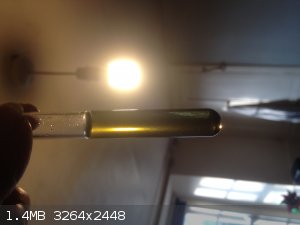
|
|
|
aga
Forum Drunkard
    
Posts: 7030
Registered: 25-3-2014
Member Is Offline
|
|
Great photos - that's a really nice surprise !
Pyrolysing ordinary bread in a tin can in the middle of a small fire gives a conductive carbon material.
The last lot i made measures about 4 ohms across 10mm (simple multimeter test).
Oh. Forgot to say: Welcome to the ScienceMadness forum !
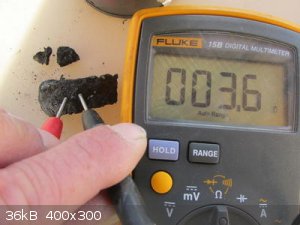
Edit:
i just tested that sample with a couple of strong magnets and it does nothing .
[Edited on 22-2-2018 by aga]
|
|
|
tacromx
Harmless

Posts: 7
Registered: 25-9-2015
Member Is Offline
Mood: No Mood
|
|
Thank you Aga.
Ill try some bread in the kiln,any estimates as to temperature and time?
|
|
|
aga
Forum Drunkard
    
Posts: 7030
Registered: 25-3-2014
Member Is Offline
|
|
Hard to say/know exactly - more experimentation needs doing.
I pyrolyse in a metal food can with a small hole in the top, using a wood fire.
It is 'done' when there is no more gas coming out of the hole, or the fire is finished.
A guess would be around 900C and 20 minutes.
|
|
|
tacromx
Harmless

Posts: 7
Registered: 25-9-2015
Member Is Offline
Mood: No Mood
|
|
I think that's doable in my kiln, bricks are rated for 1260c and element is good for just over 1100c, ill try it for 30min and see what happens(clean
underpants at the ready  ) )
Thanks for your reply and advice.
|
|
|
aga
Forum Drunkard
    
Posts: 7030
Registered: 25-3-2014
Member Is Offline
|
|
Best of luck !
Be sure to report the results here.
|
|
|
happyfooddance
National Hazard
   
Posts: 530
Registered: 9-11-2017
Location: Los Angeles, Ca.
Member Is Offline
Mood: No Mood
|
|
This is a two-necked rbf that I ruined (but kept because it looks cool) making activated carbon from lime tree bark. I put a tall column on the flask,
and connected the top of the column to a water aspirator. Heating element was a mantle for a 1000 ml flask. Had a blast shield because I had
considered implosion. Didn't implode, but the softened borosilicate did invert itself.
The carbon was some of the best I've made.
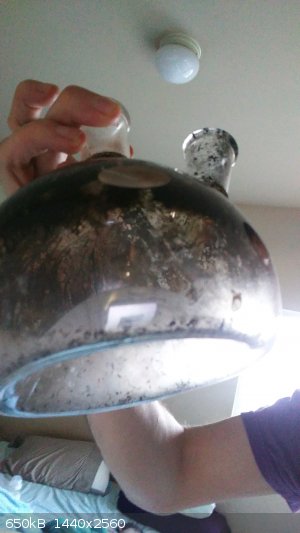
|
|
|
aga
Forum Drunkard
    
Posts: 7030
Registered: 25-3-2014
Member Is Offline
|
|
How on earth did that happen ?
|
|
|
happyfooddance
National Hazard
   
Posts: 530
Registered: 9-11-2017
Location: Los Angeles, Ca.
Member Is Offline
Mood: No Mood
|
|
Lol, strong heat and vacuum, mi amigo!
|
|
|
NEMO-Chemistry
International Hazard
    
Posts: 1559
Registered: 29-5-2016
Location: UK
Member Is Offline
Mood: No Mood
|
|
LOL might want to turn that mantel down a bit 
|
|
|
happyfooddance
National Hazard
   
Posts: 530
Registered: 9-11-2017
Location: Los Angeles, Ca.
Member Is Offline
Mood: No Mood
|
|
You live and you learn.
|
|
|
| Pages:
1
2 |